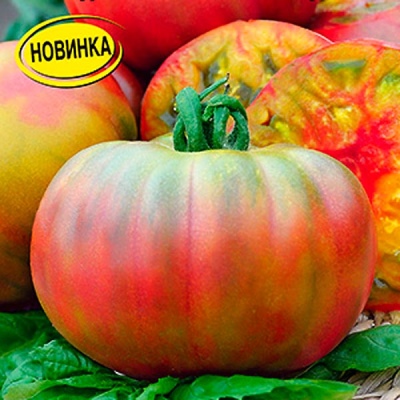
- Name synonyms: Wild Thyme
- Category: grade
- Growth type: indeterminate
- Appointment: fresh consumption
- Ripening period: mid-season
- Ripening time, days: 107-112
- Growing conditions: for open ground, for film greenhouses
- Bush size: tall
- Bush height, cm: 120
- Bush characteristic: powerful
Tomato varieties suitable for open and closed planting are the most versatile. This is the category that Wild Thyme falls into. But, in addition to this one side, it also has a number of other important properties that also deserve attention.
Description of the variety
The official synonym for the plant is Wild Thyme. This is a familiar indeterminate culture. It can be used both outdoors and in a film greenhouse. Wild thyme bushes reach a height of 1.2 m. They look powerful and impressive.
The main qualities of the fruit
Wild thyme berries are olive green in color. The specific shade depends on the light level. This tone is mixed with ruddy notes. The fruits are large, weighing 170-220 g. The pulp is colored greenish. The very first inflorescence will form over 8-9 leaves.
Taste characteristics
The sweetness of the berries is quite high. They are characterized by a pleasant meatiness. And also tasters invariably note the juiciness of this plant.
Ripening and fruiting
Wild thyme belongs to the mid-season category. Fruits appear on days 107-112 after germination. Only occasionally does the weather make significant adjustments to this schedule. It will be possible to remove the fruits from July to September.
Yield
In greenhouse conditions, you can collect 10-12 kg of fruit or more. In the open field, fertility will be slightly less. A number of sources write that the harvest in the garden is 5-8 kg / m2. But still, this variety at least deserves close attention.
The timing of planting seedlings and planting in the ground
It is necessary to place seeds in containers 60-65 days before transplanting seedlings into open ground or a greenhouse. They must be germinated in a warm place. When the first shoots appear, provide them with intense illumination. When planting in a permanent place, it makes sense to saturate the holes with wood ash. Good predecessors are:
carrot;
onion;
Dill.

Growing tomato seedlings is an extremely important process, because it largely depends on whether the gardener will be able to harvest at all. All aspects must be taken into account, from seedbed preparation to planting in the ground.
Landing scheme
Specific instructions in this regard are not given or are unclear. But the clue can be that this plant needs to be formed in a certain way. Therefore, the approach should be approximately the same as for other varieties with similar properties. And you also need to remember about the power of development of the bushes. Because of her, you will have to limit their rapprochement. Some sources write that 250-400 mm should remain between the holes.

Growing and care
Stepping and shaping are mandatory procedures in handling Wild Thyme. It is necessary to lead the bushes in 2-3 stems.In areas with short, relatively cool summers, greenhouse cultivation clearly benefits. The bushes are usually watered once every 3-5 days. In hot weather, they are more actively engaged in it, but in any case, the leaves should not be wetted.
The picking of seedlings is carried out in the phase of 1-2 true leaves. The garter is comparatively simple. Water the plants evenly - otherwise the fruits may crack. The variety needs abundant feeding. At the beginning of the formation of fruits, you will have to add phosphorus-potassium mixtures.




A plant needs different micronutrients at each stage of growth. All fertilizers can be divided into two groups: mineral and organic. Folk remedies are often used: iodine, yeast, bird droppings, eggshells.
It is important to observe the rate and period of feeding. This also applies to folk remedies and organic fertilizers.
Disease and pest resistance
The variety is tolerant to late blight, powdery mildew. It is also characterized by high resistance to top rot of fruits, verticillosis, fusarium wilt. Resistance to various kinds of bacterial infections is also great. For late blight it is recommended to treat the planting with the "Barrier" preparation. Among insects, the scoop and the Colorado potato beetle pose a threat. It can be quite difficult to stop their invasion without branded insecticides.


Resistant to adverse weather conditions
Wild thyme seedlings can be affected by drafts. But with greenhouse cultivation, ventilation must be done. Dry periods are very destructive for this plant.

























































































